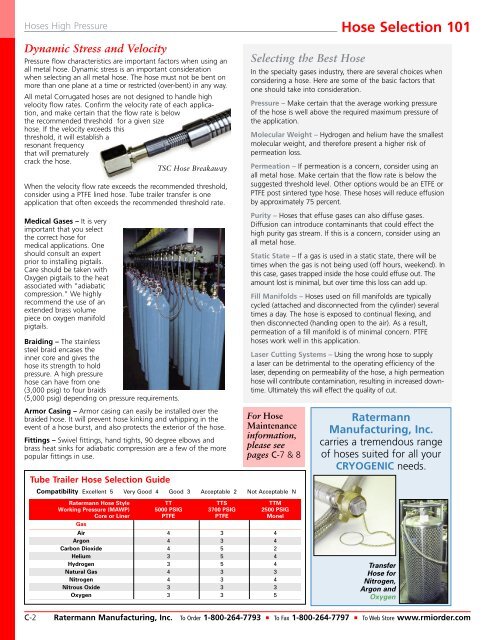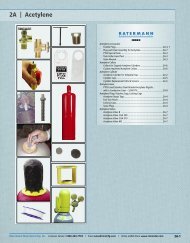Hose Selection Guide - Ratermann Manufacturing Inc
Hose Selection Guide - Ratermann Manufacturing Inc
Hose Selection Guide - Ratermann Manufacturing Inc
You also want an ePaper? Increase the reach of your titles
YUMPU automatically turns print PDFs into web optimized ePapers that Google loves.
<strong>Hose</strong>s High Pressure<br />
Dynamic Stress and Velocity<br />
Pressure flow characteristics are important factors when using an<br />
all metal hose. Dynamic stress is an important consideration<br />
when selecting an all metal hose. The hose must not be bent on<br />
more than one plane at a time or restricted (over-bent) in any way.<br />
All metal Corrugated hoses are not designed to handle high<br />
velocity flow rates. Confirm the velocity rate of each application,<br />
and make certain that the flow rate is below<br />
the recommended threshold for a given size<br />
hose. If the velocity exceeds this<br />
threshold, it will establish a<br />
resonant frequency<br />
that will prematurely<br />
crack the hose.<br />
TSC <strong>Hose</strong> Breakaway<br />
When the velocity flow rate exceeds the recommended threshold,<br />
consider using a PTFE lined hose. Tube trailer transfer is one<br />
application that often exceeds the recommended threshold rate.<br />
Medical Gases – It is very<br />
important that you select<br />
the correct hose for<br />
medical applications. One<br />
should consult an expert<br />
prior to installing pigtails.<br />
Care should be taken with<br />
Oxygen pigtails to the heat<br />
associated with “adiabatic<br />
compression.” We highly<br />
recommend the use of an<br />
extended brass volume<br />
piece on oxygen manifold<br />
pigtails.<br />
Braiding – The stainless<br />
steel braid encases the<br />
inner core and gives the<br />
hose its strength to hold<br />
pressure. A high pressure<br />
hose can have from one<br />
(3,000 psig) to four braids<br />
(5,000 psig) depending on pressure requirements.<br />
Armor Casing – Armor casing can easily be installed over the<br />
braided hose. It will prevent hose kinking and whipping in the<br />
event of a hose burst, and also protects the exterior of the hose.<br />
Fittings – Swivel fittings, hand tights, 90 degree elbows and<br />
brass heat sinks for adiabatic compression are a few of the more<br />
popular fittings in use.<br />
Tube Trailer <strong>Hose</strong> <strong>Selection</strong> <strong>Guide</strong><br />
Selecting the Best <strong>Hose</strong><br />
<strong>Hose</strong> <strong>Selection</strong> 101<br />
In the specialty gases industry, there are several choices when<br />
considering a hose. Here are some of the basic factors that<br />
one should take into consideration.<br />
Pressure – Make certain that the average working pressure<br />
of the hose is well above the required maximum pressure of<br />
the application.<br />
Molecular Weight – Hydrogen and helium have the smallest<br />
molecular weight, and therefore present a higher risk of<br />
permeation loss.<br />
Permeation – If permeation is a concern, consider using an<br />
all metal hose. Make certain that the flow rate is below the<br />
suggested threshold level. Other options would be an ETFE or<br />
PTFE post sintered type hose. These hoses will reduce effusion<br />
by approximately 75 percent.<br />
Purity – <strong>Hose</strong>s that effuse gases can also diffuse gases.<br />
Diffusion can introduce contaminants that could effect the<br />
high purity gas stream. If this is a concern, consider using an<br />
all metal hose.<br />
Static State – If a gas is used in a static state, there will be<br />
times when the gas is not being used (off hours, weekend). In<br />
this case, gases trapped inside the hose could effuse out. The<br />
amount lost is minimal, but over time this loss can add up.<br />
Fill Manifolds – <strong>Hose</strong>s used on fill manifolds are typically<br />
cycled (attached and disconnected from the cylinder) several<br />
times a day. The hose is exposed to continual flexing, and<br />
then disconnected (handing open to the air). As a result,<br />
permeation of a fill manifold is of minimal concern. PTFE<br />
hoses work well in this application.<br />
Laser Cutting Systems – Using the wrong hose to supply<br />
a laser can be detrimental to the operating efficiency of the<br />
laser, depending on permeability of the hose, a high permeation<br />
hose will contribute contamination, resulting in increased downtime.<br />
Ultimately this will effect the quality of cut.<br />
For <strong>Hose</strong><br />
Maintenance<br />
information,<br />
please see<br />
pages C-7 & 8<br />
Compatibility Excellent 5 Very Good 4 Good 3 Acceptable 2 Not Acceptable N<br />
<strong>Ratermann</strong> <strong>Hose</strong> Style TT TTS TTM<br />
Working Pressure (MAWP) 5000 PSIG 3700 PSIG 2500 PSIG<br />
Core or Liner PTFE PTFE Monel<br />
Gas<br />
Air 4 3 4<br />
Argon 4 3 4<br />
Carbon Dioxide 4 5 2<br />
Helium 3 5 4<br />
Hydrogen 3 5 4<br />
Natural Gas 4 3 3<br />
Nitrogen 4 3 4<br />
Nitrous Oxide 3 3 3<br />
Oxygen 3 3 5<br />
<strong>Ratermann</strong><br />
<strong>Manufacturing</strong>, <strong>Inc</strong>.<br />
carries a tremendous range<br />
of hoses suited for all your<br />
CRYOGENIC needs.<br />
Transfer<br />
<strong>Hose</strong> for<br />
Nitrogen,<br />
Argon and<br />
Oxygen<br />
C-2<br />
<strong>Ratermann</strong> <strong>Manufacturing</strong>, <strong>Inc</strong>. To Order 1-800-264-7793 ■ To Fax 1-800-264-7797 ■ To Web Store www.rmiorder.com





